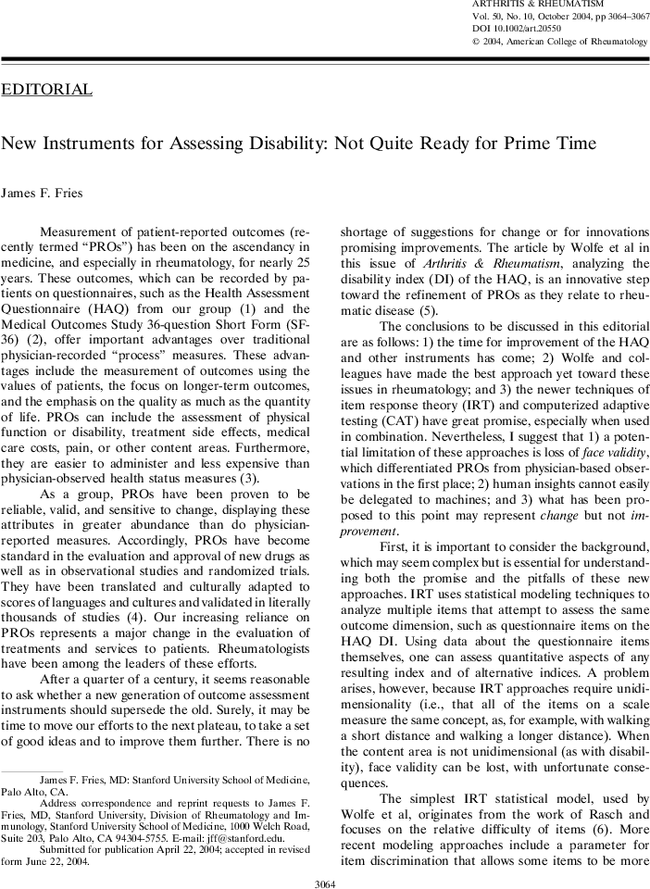Editorial
New instruments for assessing disability: Not quite ready for prime time
James F. Fries,
Corresponding Author
James F. Fries
Stanford University School of Medicine, Palo Alto, CA
Stanford University, Division of Rheumatology and Immunology, Stanford University School of Medicine, 1000 Welch Road, Suite 203, Palo Alto, CA 94304-5755Search for more papers by this authorJames F. Fries,
Corresponding Author
James F. Fries
Stanford University School of Medicine, Palo Alto, CA
Stanford University, Division of Rheumatology and Immunology, Stanford University School of Medicine, 1000 Welch Road, Suite 203, Palo Alto, CA 94304-5755Search for more papers by this author
REFERENCES
- 1 Fries JF, Spitz PW, Kraines RG, Holman HR. Measurement of patient outcome in arthritis. Arthritis Rheum 1980; 23: 137–45.
- 2 Ware JE Jr, Sherbourne CD. The MOS 36-item short-form health survey (SF-36). I. Conceptual framework and item selection. Med Care 1992; 30: 473–83.
- 3 Bruce B, Fries JF. The Stanford Health Assessment Questionnaire: a review of its history, issues, progress, and documentation. J Rheumatol 2003; 30: 167–78.
- 4 Ware JE Jr, Keller SD, Hatoum HT, Kong SW. The SF-36 arthritis-specific health index (ASHI). Med Care 1999; 37: MS40–50.
- 5 Wolfe F, Michaud K, Pincus T. Development and validation of the Health Assessment Questionnaire II: a revised version of the Health Assessment Questionnaire. Arthritis Rheum 2004; 50: 3296–305.
- 6 Linacre JM. Understanding Rasch measurement: estimation methods for Rasch measures. J Outcome Meas 1999; 3: 382–405.
- 7
Muraki E.
A generalized partial credit model. In:
V Linden, editor.
Handbook of modern item response theory.
Berlin:
Springer;
1997. p.
153–64.
10.1007/978-1-4757-2691-6_9 Google Scholar
- 8 Ware JE Jr. Conceptualization and measurement of health-related quality of life: comments on an evolving field. Arch Phys Med Rehabil 2003; 84: S43–51.
- 9 Fries JF, Ramey DR. Platonic outcomes. J Rheumatol 1993; 20: 416–8.
- 10
Wainer H,
Dorans N,
Flaugher R.
Computerized adaptive testing: a primer.
Hillsdale (NJ):
Laurence Erlbaum Associates;
2000.
10.4324/9781410605931 Google Scholar
- 11 Ware JE Jr, Bjorner JB, Kosinski M. Practical implications of item response theory and computerized adaptive testing: a brief summary of ongoing studies of widely used headache impact scales. Med Care 2000; 38: S73–82.
- 12 Lai JS, Cella D, Chang CH, Bode RK, Heinemann AW. Item banking to improve, shorten and computerize self-reported fatigue: an illustration of steps to create a core item bank from the FACIT-Fatigue Scale. Qual Life Res 2003; 12: 485–501.
- 13 US Department of Health and Human Services. Dynamic assessment of patient-reported chronic disease outcomes. Bethesda (MD): National Institutes of Health; November 18, 2003. Publication RFA-RM-04-011.




